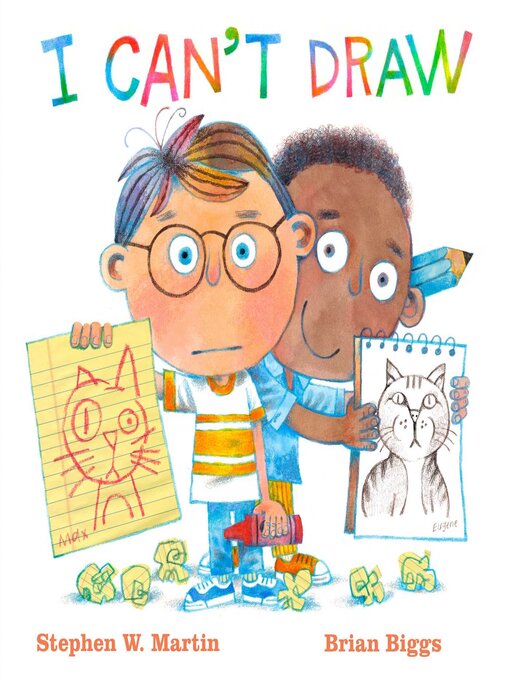Max loves to draw, but he's not very good at it. No, seriously, just look at some of his drawings. Ouch. So he asks his best friend, Eugene, for help. Working side by side, it's pretty obvious there's no hope for Max. Until Eugene has a brilliant idea, and they find a way to use Max's unique talents to turn up the awesome and have some fun! A lot of fun!
Brian Bigg's hilarious illustrations join Stephen W. Martin's conversational text to create a laugh-out-loud read about embracing your talent and creativity that budding artists everywhere will relate to!
-
Creators
-
Publisher
-
Awards
-
Release date
October 18, 2022 -
Formats
-
Kindle Book
-
OverDrive Read
- ISBN: 9781534493421
-
-
Languages
- English
-
Levels
- Lexile® Measure: 500
- Text Difficulty: 1-2
-
Reviews
-
Kirkus
July 15, 2022
What makes a good drawing? Accuracy or embellishment? This ode to the triumphs and difficulties of drawing opens with the step-by-step construction of a cat. A child named Max then proclaims, "I can't draw!" Wadded-up scraps of paper on the ground are signs of Max's frustration as they display their efforts at creating a space cat and a horse. Sorta. In contrast is the horse that Max's friend Eugene has drawn, a prancing, beautifully rendered equine. Max proceeds to offer Eugene cupcakes in exchange for lessons, which Eugene does, first by giving Max a book and then by working side by side with Max on landscapes, animals, and self-portraits. Alas, only tracing improves Max's efforts. But Max and their imagination carry the day as the child proceeds to jazz up Eugene's precise renderings, adding dinosaurs, lasers, and robots--unpolished but attention-grabbing additions. Whether they can draw well or just love to draw, children will enjoy the efforts and friendship of the two round-faced characters. Max's work is rendered in crayon and Eugene's work in graphite pen. Additional, colorful illustrations are done with colored pencils, pastels, and ink. All are child-friendly and appealing, reflecting both characters' talents and passions. Coming full circle, the book concludes with Max's personalized step-by-step instructions for drawing a cat. Max is light-skinned and bespectacled; Eugene is dark-skinned. (This book was reviewed digitally.) In this relatable account, a child's struggles to draw turn to triumph. (Picture book. 4-7)COPYRIGHT(2022) Kirkus Reviews, ALL RIGHTS RESERVED.
-
Publisher's Weekly
August 29, 2022
White-presenting Max, a brash kid with snark to spare, views his perceived lack of drawing skills as a problem to solve. A blocky, crudely crayoned drawing on legal paper makes the situation plain: Max can draw, he’s just not executing to the level he would prefer. He asks the audience to guess what he’s rendered: “It starts with the letter H.” “Yes,” exults Max, with a clenched fist: “It is a horse!! I nailed it!!!” When the horse has the last word (“Did you though? DID YOU?”), though, Max enlists the help of artist classmate Eugene, portrayed with brown skin. In Biggs’s hands, Eugene’s drawings are small classical masterpieces against which Max’s cartoon scrawls offer amusing contrast. Eugene recommends drawing fruit as practice; Max would rather draw a robot stomping on the fruit. Yet an unexpected technique allows Max to mimic Eugene’s style, leading to a
collaboration that combines Eugene’s skill with Max’s “flavor.” Martin (Fluffy McWhiskers Cuteness Explosion) clearly plumps for collaboration over competition (“I forgot all about trying to draw like Eugene”) in a portrait of creative fulfillment, but it’s Max’s story all the way. Ages 4–8. -
Booklist
October 15, 2022
Preschool-Grade 2 Max and Eugene are both budding artists, although Eugene's technical skills surpass Max's. Eugene offers several suggestions (including tracing) that give Max more confidence, yet Max senses something is still missing from his work. Eventually Max realizes that while skill is important, so too is imagination, which in Max's case involves robots, snarky comments, and anachronistic details. Martin's simple, heartfelt story is sure to strike a chord with kids, especially those whose expertise is still developing. Biggs' illustrations depict Max's work in crayon, often on lined yellow paper; Eugene's works appear in graphite pencil in a proper sketchbook. Other spreads are rendered in full-color mixed media. The cartoon style will appeal to the intended audience; so will the lasers, butt references, and comics conventions that Max's work employs. With endpapers depicting ""How to Draw a Cat,"" by Eugene (in the front) and Max (at the back), this should encourage frustrated or timid young artists as well as validate the imaginative embellishments they so admire.COPYRIGHT(2022) Booklist, ALL RIGHTS RESERVED.
-
subjects
Languages
- English
Levels
- Lexile® Measure:500
- Text Difficulty:1-2
Loading
Why is availability limited?
×Availability can change throughout the month based on the library's budget. You can still place a hold on the title, and your hold will be automatically filled as soon as the title is available again.
The Kindle Book format for this title is not supported on:
×- - Kindle 1
- - Kindle 2
- - Kindle 4
- - Kindle 5
- - Kindle 7
- - Kindle DX
- - Kindle Keyboard
- - Kindle Paperwhite
- - Kindle Touch
- - Kindle Voyage
Read-along ebook
×The OverDrive Read format of this ebook has professional narration that plays while you read in your browser. Learn more here.



